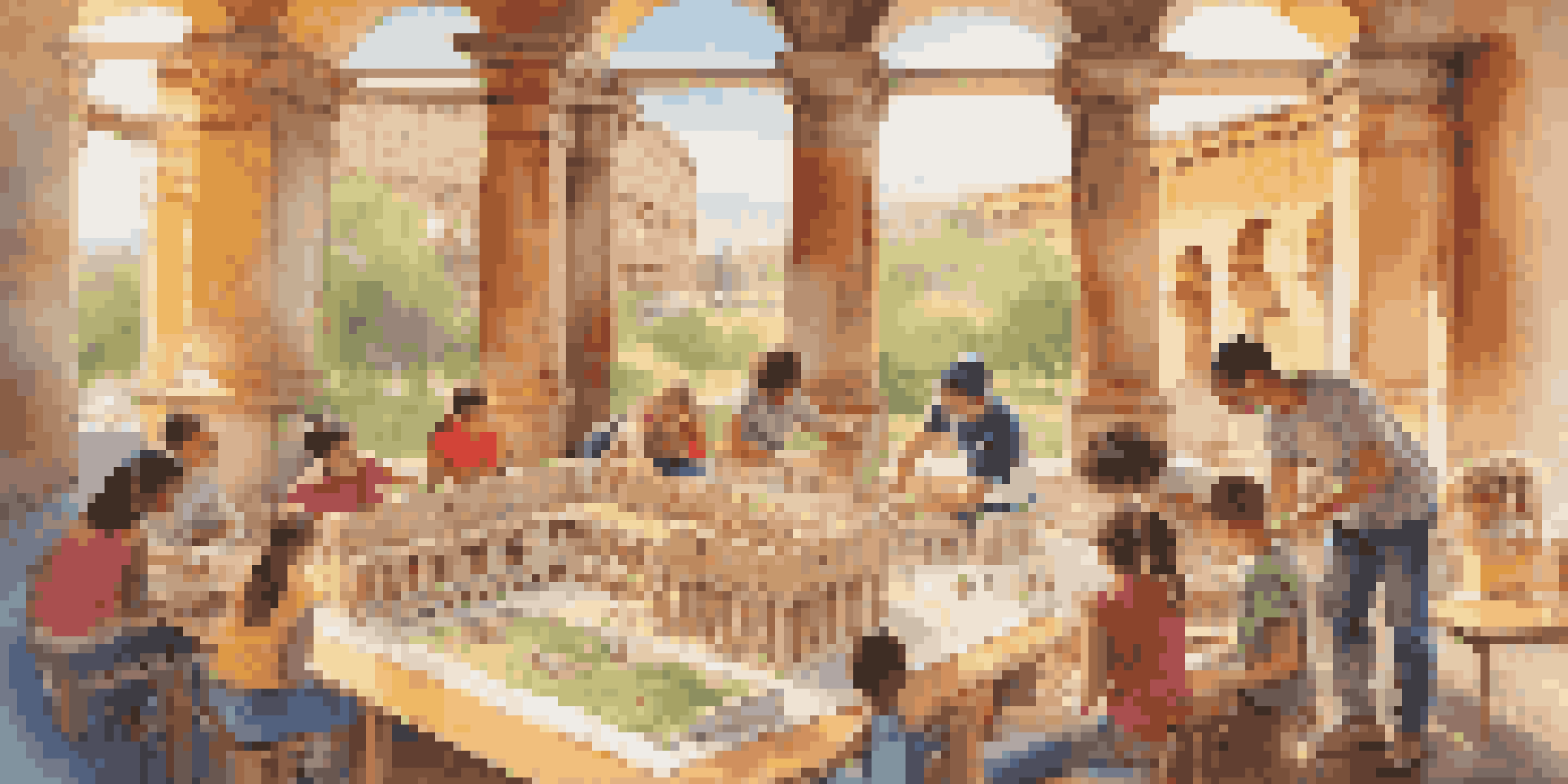The Significance of Scale Models in Education

What Are Scale Models and Their Purpose in Education?
Scale models are miniature representations of objects, structures, or systems, often used in educational settings to enhance understanding. They can range from simple geometric shapes to complex architectural designs, providing a tangible way to visualize concepts. By seeing a scaled-down version of a subject, students can grasp dimensions, proportions, and relationships more effectively.
The greatest gifts you can give your children are the roots of responsibility and the wings of independence.
These models serve as valuable tools for kinesthetic learners, who thrive on hands-on experiences. For example, when studying architecture, a scale model of a building allows students to explore design elements and spatial relationships that are difficult to appreciate through drawings alone. This tactile interaction deepens their engagement and retention of the material.
Moreover, scale models can foster collaboration among students. Working together to create or analyze these models encourages teamwork and communication, vital skills in any educational journey. Whether in a classroom or a workshop, the shared experience of working with scale models can spark creativity and innovation.
Enhancing STEM Learning Through Scale Models
In the realm of STEM (Science, Technology, Engineering, and Mathematics), scale models play a crucial role in demystifying complex concepts. For instance, engineering students can build scale models of bridges to test structural integrity, allowing them to apply theoretical knowledge in a practical context. This hands-on approach not only reinforces learning but also encourages critical thinking.

Additionally, scale models can be utilized in scientific experiments, such as simulating ecosystems or weather patterns. By manipulating these models, students can observe how changes in one element affect the system as a whole, reinforcing the interconnectedness of scientific principles. This experiential learning fosters a deeper understanding of scientific inquiry and experimentation.
Scale Models Enhance Learning
Scale models provide tangible ways for students to visualize and understand complex concepts across various subjects.
Furthermore, scale models can be integrated into technology education, where students can design and prototype their own models using digital tools. This process not only enhances their technical skills but also encourages innovation and problem-solving. By bridging the gap between theoretical knowledge and practical application, scale models are invaluable in the STEM curriculum.
Scale Models in History and Geography Education
Scale models are not limited to STEM; they also play a significant role in history and geography education. When studying ancient civilizations, students can explore scale models of historical landmarks, such as the Pyramids of Giza or the Parthenon. This visual and tactile representation helps them appreciate the architectural achievements and cultural significance of these structures.
Learning is a treasure that will follow its owner everywhere.
In geography classes, scale models of terrain can help students understand topography, land use, and spatial relationships. For example, a model of a river system allows students to visualize how water flows through different landscapes, making concepts like erosion and sedimentation more relatable. This hands-on exploration makes geography come alive in ways that textbooks cannot.
Moreover, incorporating scale models into history lessons encourages storytelling and critical thinking. Students can create their own models to represent historical events, prompting them to research and engage with the material on a deeper level. This creative approach not only enhances retention but also fosters a love for learning about the past.
The Role of Scale Models in Arts Education
In arts education, scale models serve as vital tools for visualizing and experimenting with artistic concepts. For instance, aspiring sculptors can create small-scale models of their work before committing to full-sized pieces. This practice not only helps in refining their ideas but also allows for experimentation with proportions, materials, and aesthetics.
Additionally, scale models can assist in set design for theater or film productions. Students can build miniature representations of stage layouts, enabling them to visualize how different elements interact within a space. This process encourages collaboration among students from various disciplines, such as drama, design, and architecture, fostering a multidisciplinary approach to creativity.
Hands-On Experience in Education
Engaging with scale models fosters collaboration, creativity, and critical thinking, making learning more interactive and effective.
Furthermore, using scale models in art projects can enhance spatial awareness and design thinking. By manipulating three-dimensional forms, students can better understand balance, symmetry, and composition. This hands-on experience in arts education promotes creativity and innovation, essential skills for any aspiring artist.
Scale Models in Environmental Education
Environmental education greatly benefits from the use of scale models, as they help illustrate complex ecological systems. For instance, models of wetlands or forests allow students to visualize biodiversity and the interdependence of organisms within these ecosystems. By analyzing these models, students can better understand environmental challenges and conservation efforts.
Moreover, scale models can be used to demonstrate the impact of human activity on the environment. For example, a model of a city can illustrate how urban planning affects local ecosystems, such as water runoff and habitat destruction. This exploration encourages students to think critically about sustainability and their role in protecting the environment.
Additionally, students can engage in projects that involve creating their own scale models of sustainable solutions, such as green buildings or renewable energy systems. This hands-on approach not only fosters creativity but also empowers students to envision practical applications of environmental concepts. Through these experiences, they develop a deeper appreciation for ecological balance and sustainability.
Incorporating Scale Models in Educational Curricula
Integrating scale models into curricula requires thoughtful planning and creativity from educators. Teachers can start by identifying key concepts across subjects that would benefit from a visual or tactile representation. For example, a history lesson on ancient Rome could include building a scale model of the Colosseum, allowing students to explore its architectural significance while learning about the culture.
Furthermore, collaboration among teachers can enhance the use of scale models in interdisciplinary projects. For instance, art and science teachers can team up to create a project where students design scale models of sustainable homes, merging artistic creativity with scientific principles. This collaboration not only enriches the learning experience but also encourages students to see the connections between different subjects.
Future of Learning with Technology
Advancements like 3D printing and virtual reality are transforming how students interact with scale models, enhancing engagement and understanding.
Additionally, educators can leverage technology by using digital tools to create virtual scale models, making it accessible for all students. This approach allows for experimentation and revision without the constraints of physical materials. By fostering an environment where scale models are embraced, educators can inspire curiosity and deepen understanding across various subjects.
The Future of Scale Models in Education
As technology continues to evolve, the future of scale models in education looks promising. Advancements in 3D printing and virtual reality are revolutionizing how students interact with models. For example, students can create intricate scale models using 3D printers, bringing their designs to life with precision and detail. This hands-on experience not only enhances their technical skills but also fosters creativity.
Moreover, virtual reality (VR) offers immersive experiences that allow students to explore scale models in a digital environment. Imagine stepping into a VR simulation of a historical site or an architectural structure, where students can interact with the model in real-time. This engaging approach makes learning more dynamic and captivating, catering to diverse learning styles.

Ultimately, as educators embrace innovative technologies, scale models will continue to play a vital role in fostering engagement and understanding. By adapting to the changing educational landscape, these models will remain essential tools for inspiring curiosity and enhancing learning experiences for future generations.